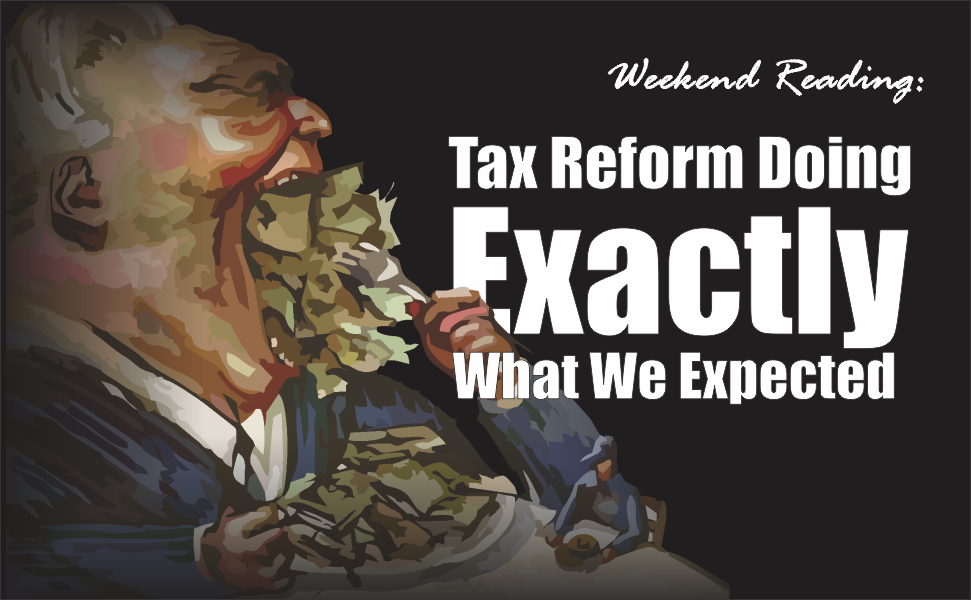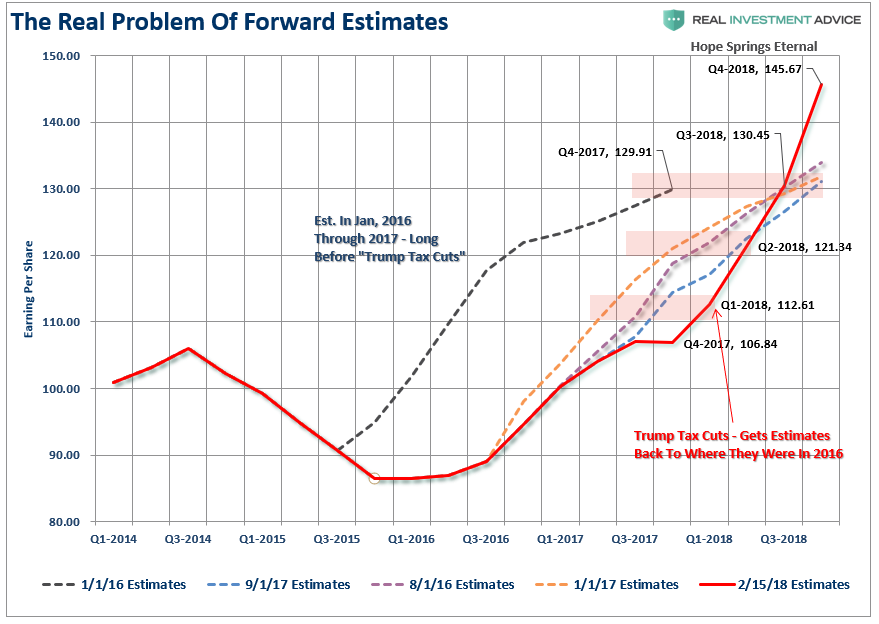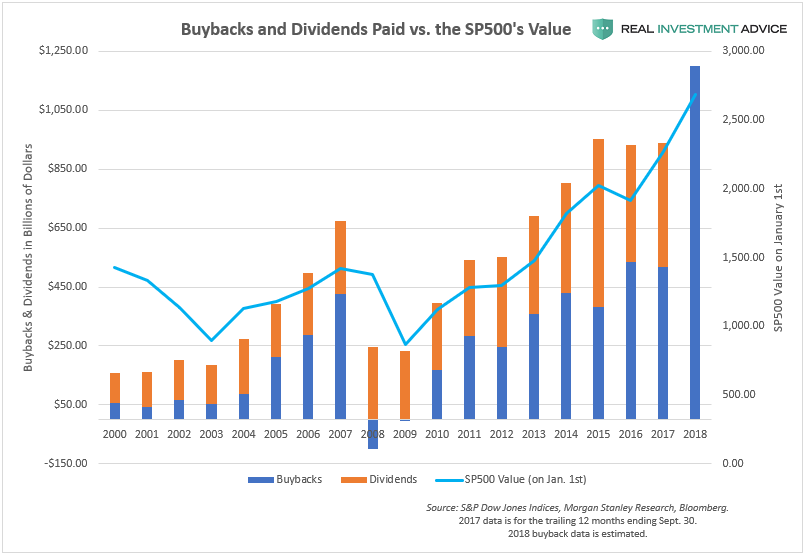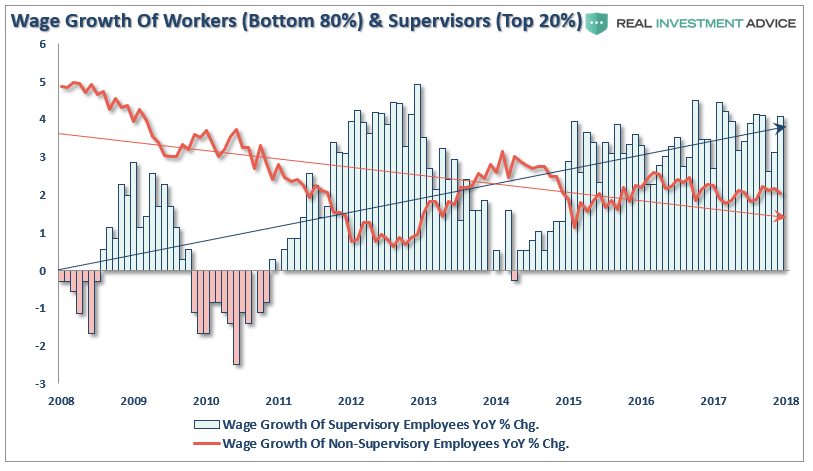Weekend Reading: Tax Reform Doing Exactly What We Expected

Shortly after the Tax Cut/Reform bill was passed by Congress, I did some analysis discussing the various myths of how those “tax cuts,” since they were primarily focused on corporations, would actually turn out.
Well, just two months into 2018, we already have some answers.
Myth 1:Tax cuts will lead to a huge ramp-up in earnings.
The problem with the idea that tax cuts will result in a huge increase in bottom-line earnings, is that estimates got way ahead of reality.
For example, in October of 2017, the estimates for REPORTED earnings for Q4, 2017 and Q1, 2018 were $116.50 and $119.76 respectively. As of February 15th, the numbers are $106.84 and $112.61 or a difference of -$9.66 and -7.15 respectively.
First, while asset prices have surged to record highs, reported earnings estimates through Q3-2018 have already been ratcheted back to a level only slightly above where 2017 was expected to end in 2016. As shown by the red horizontal bars – estimates through Q3 are at the same level they were in January, 2017. (Of course, “hope springs eternal that Q4 of this year will see one of the sharpest ramps in earnings in S&P history.)
(Click on image to enlarge)

Wall Street ALWAYS over-estimates earnings and by about 33% on average. That overestimation provides a significant amount of headroom for Wall Street to be disappointed by year end, particularly once you factor in the “effective” tax rate that most companies actually pay.
But even if we give Wall Street the benefit of the doubt and assume their predictions will be correct for the first time in human history, stock prices have already priced in twice the rate of EPS growth.
(Click on image to enlarge)

It is quite likely that once again Wall Street is extrapolating the last few quarters of earnings growth ad infinitum and providing even more fodder for the market rally. It is also quite likely Wall Street will be proven wrong on earnings as so often has occurred in the past.
Myth 2: Corporations will use those tax cuts to hire employees and boost wages
“The same is true for the myth that tax cuts lead to higher wages. Again, as with economic growth, there is no evidence that cutting taxes increases wage growth for average Americans. This is particularly the case currently as companies are sourcing every accounting gimmick, share repurchase or productivity increasing enhancement possible to increase profit growth.“
Not surprisingly, our guess that corporations would utilize the benefits of “tax cuts” to boost bottom line earnings rather than increase wages has turned out to be true. As noted by Axios, in just the first two months of this year companies have already announced over $173 BILLION in stock buybacks. This is “financial engineering gone mad” and something RIA analyst, Jesse Colombo, noted yesterday:
“How have U.S. corporations been deploying their new influx of capital? Unlike in prior cycles – when corporations favored long-term business investments and expansions – corporations have largely focused on juicing their stock prices via share buybacks, dividends, and mergers & acquisitions. While this pleases shareholders and boosts executive compensation, this short-term approach is detrimental to the long-term success of American corporations. The chart below shows the surge in share buybacks and dividends paid, which is a direct byproduct of the current artificially low interest rate environment. Even more alarming is the fact that share buybacks are expected to exceed $1 trillion this year, which would blow all prior records out of the water. The passing of President Donald Trump’s tax reform plan was the primary catalyst that encouraged corporations to dramatically ramp up their share buyback plans.”
(Click on image to enlarge)

“What is even more unwise about the current share buyback mania is the fact that it is occurring at extremely high valuations, which is tantamount to ‘throwing good money after bad.'”
Furthermore, there is scant evidence that wages are improving for the masses versus those in the executive “C-suite.”
(Click on image to enlarge)

While well-designed tax reforms can certainly provide for better economic growth, those tax cuts must also be combined with responsible spending in Washington. That has yet to be the case as policy-makers continue to opt for “continuing resolutions” that grow expenditures by 8% per year and tack on another $2 Trillion in spending rather than doing the hard work of passing a budget.
Policymakers had the opportunity to pass true, pro-growth, tax reform and show they were serious about our nations fiscal future, they instead opted to continue enriching the top 1% at the expense of empowering the middle class.
In the end, it is all working out exactly like we expected.
Here is your weekend reading list.
Economy & Fed
- Have Both Sides Misunderstood Tax Cuts by Geoff Colvin via Fortune
- Trump Needs To Return “King Dollar” by Lawrence Kudlow via RCM
- Trump Will Cause The Next Recession by David Dayen via The New Republic
- The Biggest Lies About Trump’s Budget by Stan Collender via Forbes
- The Economy Is Booming by Gary Shapiro via The American Spectator
- Is The Economic Tide About To Go Out? by Pater Tenebrarum via Acting Man blog
- Dangerous Thinking On Deficits by Scott Sumner via The Money Illusion
Markets
- Come The Next Recession, Don’t Count On That Safety Net by Eduardo Porter via NY Times
- Fed President Sounds Alarm On US Debt by Tyler Durden via ZeroHedge
- The Fed’s Problem With Interest Income by Edward Harrison via Credit Writedowns
- How Inflation & Rates Affect Stocks by James Picerno via Capital Spectator
- Tales We’ll Be Told In The Next Downturn by Jonathan Clements via Humble Dollar
- Best Ways To Weather This Market by Paul Sullivan via NYT
- Bearish Bond Data May Be Leading Traders Astray by David Ader via Bloomberg
- Time To Buy What’s Not Hot by Simon Maierhofer via MarketWatch
- Why Worst May Be Over by Ryan Vlastelica via MarketWatch
- Why Yields Have Investors Worried by Sunny Oh via MarketWatch
- Analysts On TV Don’t Understand How Economy Works by Jonathon Trugman via NY Post
- Corporate Debt & The Everything Bubble by Jesse Colombo via RIA
- Recent Volatility Is A Gift For Investors by John Coumarianos vis RIA
Research / Interesting Reads
- Record Short Treasury Bets Begs Reversion by Dana Dovey via Newsweek
- Applying Wisdom Of John Wooden To Your Investments by Michael Cannivet via RCM
- 10-Breakthrough Technologies For 2018 via MIT Technology Review
- The Downside Of Capitalism by Tim Wu via NYT
- Will You Outlive Your Retirement Savings by Maurie Backman via Motley Fool
- Always In Need Of Thinkers Like Bastiat by Henry Hazlitt via Mises Institute
- Rydex Bears Come Out Of Hibernation by Dana Lyons via The Lyons Share
- Nothing To Fear But Fear Itself by Jesse Felder via The Felder Report
“Based on my own personal experience – both as an investor in recent years and an expert witness in years past – rarely do more than three or four variables really count. Everything else is noise.” ― Martin Whitman
Disclosure: The information contained in this article should not be construed as financial or investment advice on any subject matter. Real Investment Advice is expressly disclaims all liability in ...
more


